Campfire Audio have been churning out some beautifully designed and crafted IEMs lately – machined aluminium in gorgeous industrial, but ergonomic shapes, unique resonators in place of the more common sound tubes, beautiful and high quality cables with MMCX connectors and sound tuning that is equal parts varied and consistently enjoyable. Admittedly, their dynamic driver-based Lyra model didn’t wow me, but the balanced armature-based Jupiter and Orion models were both great.
At the time I reviewed the Jupiter IEM it was the top of the line offering from Campfire Audio at $899 USD (direct from their site). Since then they have released the lower level Nova IEM and the new top of the line IEM, the Andromeda, retailing at $1099 USD. I was excited to see what magic Campfire Audio wove to build on their already excellent range and, on first listen, the Andromeda showed all the signs of being the perfect amalgamation of the outstanding performance and tuning demonstrated in the earlier models.
Specifications
- Frequency response: 10 – 28,000Hz
- Sensitivity: 115 dB SPL / mW
- Impedance: 12.8 ohms at 1kHz
- Drivers: 5 x balanced armatures per side
Design & Accessories
 Like all of the Campfire Audio range of IEMs, the Andromedas are a combination of impeccable design and luxurious appointment. The Andromedas come with a beautiful, dark leather carry case lined with wool (or synthetic wool – I’m not sure), a high-quality braided cable, a broad selection of silicone and foam ear tips, and a cleaning tool. All-in-all it’s an outstanding range of accessories that makes the Andromedas feel every bit as high-end as their price tag suggests.
Like all of the Campfire Audio range of IEMs, the Andromedas are a combination of impeccable design and luxurious appointment. The Andromedas come with a beautiful, dark leather carry case lined with wool (or synthetic wool – I’m not sure), a high-quality braided cable, a broad selection of silicone and foam ear tips, and a cleaning tool. All-in-all it’s an outstanding range of accessories that makes the Andromedas feel every bit as high-end as their price tag suggests.
Aesthetics & Ergonomics
Beyond the accessories, the design of the Andromedas is equally high-end. The housings are machined from aluminium and finished in a rich, anodised green that’s reminiscent of British Racing Green as used on some classic vintage sports cars. It’s not a colour you normally see in the audio world, but it’s a great looking colour and makes the Andromedas a truly unique option, aesthetically speaking. As well as the aesthetics, the choice of aluminium housings means you know that they are rigid and not creating mechanical distortion in the sound reaching your ears.
Ergonomically, the Andromedas are a more comfortable design than they look. They look far too angular at first glance, but the Orion and Jupiter models proved to me convincingly that the angles and curves are in all the right places to produce a comfortable wearing experience. The silver-coloured nozzle is quite chunky, but it’s still small enough in diameter to fit into my slightly troublesome ears. I wouldn’t want to wear these while exercising because the nozzle prevents a truly secure fit in my ears, but they fit well enough to seal the ear canal and reproduce their optimal sound without any hint of discomfort.
Driver Configuration
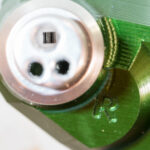 The Andromedas are a 5-driver design which means that each earpiece contains 5 balanced-armature drivers. That’s not particularly unique in the earphone world, but the Andromedas share the unique technology pioneered by their older siblings – a tubeless resonator design. I can’t say exactly what that means (because I don’t know, not because I’m sworn to secrecy), but the essence of it is that the traditional tube system to carry sounds from the drivers to tip of the nozzle in most IEMs is replaced by this unique approach in the new Campfire Audio IEMs. Looking closely at the nozzles on the Andromedas, it appears as though each driver or set of drivers (e.g. bass, mid and/or treble groupings) deliver sounds into chambers which are controlled for resonance with damping or similar techniques. The sounds then exit the chambers via the openings in the nozzle without the potential turbulence or resonance that plastic tubes could make.
The Andromedas are a 5-driver design which means that each earpiece contains 5 balanced-armature drivers. That’s not particularly unique in the earphone world, but the Andromedas share the unique technology pioneered by their older siblings – a tubeless resonator design. I can’t say exactly what that means (because I don’t know, not because I’m sworn to secrecy), but the essence of it is that the traditional tube system to carry sounds from the drivers to tip of the nozzle in most IEMs is replaced by this unique approach in the new Campfire Audio IEMs. Looking closely at the nozzles on the Andromedas, it appears as though each driver or set of drivers (e.g. bass, mid and/or treble groupings) deliver sounds into chambers which are controlled for resonance with damping or similar techniques. The sounds then exit the chambers via the openings in the nozzle without the potential turbulence or resonance that plastic tubes could make.
It’s worth noting that there are many amazing IEMs on the market that manage to sound exquisite while using the traditional nozzle approach (and may actually benefit from them by extending the lengths of the nozzles to adjust for timing variations between frequencies) so it’s not fair to say that this technology instantly raises the Campfire Audio products above their competition, but the tubeless resonator technology certainly doesn’t seem to harm the sound and therefore may conceivably be improving it.
Sound
If you’ve listened to your friendly neighbourhood Muppet you’d be forgiven for thinking that it’s not easy being green, but the Campfire Audio Andromeda puts forward a very strong argument that green is actually a very, very easy colour. The sound from the Andromedas is effortless in that annoying way that some people can be athletic. What I mean is that there’s no sense of strain or effort, but equally there is no sense of flaw or laziness. Individually, every part of the Andromedas’ sonic presentation is outstanding. Altogether though? Read on so I can explain…
Treble
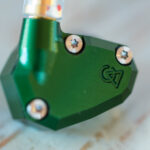 Campfire Audio market the Andromedas with the claim that “this system’s high frequency extension is unattainable using conventional techniques”, referring to the tubeless resonator system discussed above. I’m not geared up for accurate and reliable measurement so I tend to rely on my subjective enjoyment over long-term listening across varied sources and genres, but I can definitely confirm that there is no lack of extension to the treble from the Andromedas and the treble they deliver is super smooth with no hint of sibilance and no sense of any significant peaks or troughs that I can hear. Admittedly I don’t resort to listening to frequency sweeps these days, but real-world usage of the Andromedas left me completely satisfied with their treble performance.
Campfire Audio market the Andromedas with the claim that “this system’s high frequency extension is unattainable using conventional techniques”, referring to the tubeless resonator system discussed above. I’m not geared up for accurate and reliable measurement so I tend to rely on my subjective enjoyment over long-term listening across varied sources and genres, but I can definitely confirm that there is no lack of extension to the treble from the Andromedas and the treble they deliver is super smooth with no hint of sibilance and no sense of any significant peaks or troughs that I can hear. Admittedly I don’t resort to listening to frequency sweeps these days, but real-world usage of the Andromedas left me completely satisfied with their treble performance.
Compared to the Jupiters, the Andromedas have a better overall treble balance, but don’t lose any overall sense of treble energy or detail – they just balance all the treble frequencies out more evenly without any spikes. The Jupiters had good treble, but the Andromedas have great treble. That said, the amount of treble may not be perfect for listeners with tastes similar to me. Very importantly here I want to clarify that the following remarks are about the amount of treble, not the quality of the treble – the quality of the treble is marvellous. Where the problem lies for me is that I find the treble to be slightly too prominent in the overall sound signature. As good as the treble is, I don’t want it to be the star of the show at the expense of sonic balance and the Andromedas definitely have a slight tilt towards a V-shaped signature. My listening tastes align neatly with the Noble Kaiser 10 and AudioQuest NightHawk – two products that are supremely organic and musical. To my ears, the Andromedas are leaning a bit more towards Hi-Fi rather than organic musicality. That’s not a criticism because they sound spectacular at what they do with treble, but the signature is just not my preference. However, for those that like the increase in perceived resolution, increased sense of space and the sparkle of great treble, the Andromedas are worth an audition.
Mids
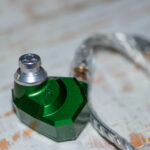 This is going to be a bit of a tangent for a moment, but this is the second time I have written the rest of this review and I still don’t completely understand what happened, but the Andromedas went from being my second favourite IEM ever, to a complete disappointment and then back to being awesome again. Let me explain…
This is going to be a bit of a tangent for a moment, but this is the second time I have written the rest of this review and I still don’t completely understand what happened, but the Andromedas went from being my second favourite IEM ever, to a complete disappointment and then back to being awesome again. Let me explain…
My preliminary listening to the Andromedas was conducted using a mobile setup with the AudioQuest DragonFly Red DAC and sometimes adding the FiiO E12DIY amplifier to the mix. The result was a marvellously engaging musical experience that was both technically exciting and emotionally enthralling – the combination that I am always seeking when reviewing gear, but rarely achieve. Imagine my surprise when I came home and connected the E12DIY to the much more expensive and higher-spec Matrix X-Sabre DAC expecting significant improvements in sound quality. I’d previously confirmed for myself that the X-Sabre comfortably outperforms the DragonFly Red (as it should) so why was the sound from the Andromedas suddenly so disappointing, so incoherent and disengaging. The mids seemed a bit recessed, the bass notes were punchy and well-weighted, but sometimes not properly connected to the rest of the music. The Andromeda review suddenly took a turn for the worse so I played around a bit and discovered that something about the pairing with the DragonFly was producing the absolute best from the Andromedas (with or without a separate amp in the mix). I don’t yet have an answer for the issue (interconnects perhaps?) but what I do know is that the Andromedas might be one of those highly sensitive (115dB), low impedance (12.8 ohms) earphones that you need to be very careful with when pairing with sources. That’s the only explanation I can come up with because my X-Sabre rig has been a stellar performer for a couple of years now with no sense of the flaws I heard when demoing the Andromedas.
Anyway, what does all this mean? It means that the Andromedas are so good that I had to revisit my early impressions and completely rewrite the erroneous judgements I penned when the rig wasn’t doing them justice.
As I already alluded to above, the mids on the Andromedas are slightly less prominent than the treble and that’s a shame because the mids are glorious. They are full, well-weighted and immensely enjoyable. If Campfire Audio were to pull back the treble emphasis these might have been my favourite ever IEMs, but as it is they are sitting pretty in second place I think. Whether reproducing female vocals, male vocals or instrumentals there is a wonderfully engaging presence and focus to the mid-range from the Andromedas. Everything is crystal clear and sharply focussed, but rendered with a warmth that keeps everything completely realistic and natural – I just wish the treble didn’t occasionally demand attention away from the mids.
When compared to my favourite IEMs, the Noble Kaiser 10s, the Andromedas not only hold their own, but are actually even more engaging in many ways. I still prefer the slightly tamed treble from the K10s, but the laser-sharp focus and natural rendering of the vocals and instrumentals from the Andromedas might be impossible to beat. In fact, the Andromedas’ mids remind me of the insane mid-range quality from the FitEar ToGo! 334.
Bass
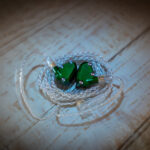 The bass quality and quantity from the Andromedas is really impressive! The other IEMs I’ve reviewed in the Campfire Audio range (Jupiter, Orion and Lyra) all had nice bass presentations in their own ways, but the Andromedas stepped it up. The Andromedas have impressive punch and weight in their bass presentation. In fact, I wonder if Campfire Audio have employed one of those huge, bass-specific BA drivers like those used by Noble Audio in the K10 and Noble 5 (now the Dulce Bass I believe). There is also very good extension to the bass – something that BA IEMs have gotten better and better at over recent years and the Andromedas are definitely keeping pace with excellent weight and presence right down to the lowest audible bass registers.
The bass quality and quantity from the Andromedas is really impressive! The other IEMs I’ve reviewed in the Campfire Audio range (Jupiter, Orion and Lyra) all had nice bass presentations in their own ways, but the Andromedas stepped it up. The Andromedas have impressive punch and weight in their bass presentation. In fact, I wonder if Campfire Audio have employed one of those huge, bass-specific BA drivers like those used by Noble Audio in the K10 and Noble 5 (now the Dulce Bass I believe). There is also very good extension to the bass – something that BA IEMs have gotten better and better at over recent years and the Andromedas are definitely keeping pace with excellent weight and presence right down to the lowest audible bass registers.
There’s a nice lift to the bass from the Andromedas, but it’s been executed in a very considered and balanced way. The result is wonderful punch, weight and depth while never straying from a neutral and accurate overall sound signature. The bass is quick and controlled, but never seems to lack body and presence – a masterful piece of tuning indeed! The Andromedas are equally as adept with acoustic, classical, electronic or rock (or anything else I threw at them) because the bass is so accurate and never over steps the mark.
I decided to put the Andromedas up against the Kaiser 10s again and used the thumping kick bass of Everlasting Light [Live] by The Black Keys to see how well they both performed. The Andromedas delivered visceral thump and rapid decay so everything sounded solid and full, but agile and clean. Moving to the K10s brought some extra weight to the bass without losing the speed. On bass presentation alone (discounting the Andromedas’ exceptional mid-range), the Nobles had a slight edge so I tried Elijah Rock from Harry Connick Jr.’s Oh, My Nola album. This is a much cleaner recording of a really thumpy kick drum and bass. Once again the competition is super close and once again I’d give the bass edge to the Nobles. Interestingly, on this recording (which is excellent) I would also give an overall edge to the Nobles because the treble energy from the Andromedas creates a very slightly unnatural presentation of the overall performance.
Staging & Imaging
One of the benefits of treble emphasis (even only slight emphasis) is the potential to massively increase the perceived soundstage size and also the accuracy of the image. When done right, as it is with the Andromedas, the resulting presentation is nothing short of astounding and that is completely true here. The Andromedas produce the best soundstage I have ever experienced in a headphone or an earphone. Being a sealed in-ear design, the Andromedas can’t compete with a fully open headphone for sheer soundstage size, but they are far more accurate with imaging and sound placement. The resulting balance of size and imaging accuracy is beguiling and has me seriously considering a purchase even though I already own one of the best IEMs on the market.
Conclusion
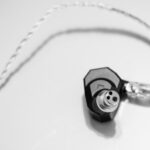 The Andromedas are easily one of the best earphone or headphone products I have ever had the pleasure to audition or own. They easily hold their own against the very best flagship IEMs on the market and are a spectacular blend of technical expertise and masterful tuning. Although they pack a little more treble energy than I personally like, most people will absolutely love the presentation as it’s right in line with the preferred signatures around the Head-Fi world. What sets the Andromedas apart though is the perfection with which they execute this common sound-signature. The tubeless resonators must be doing something good because the Andromedas offer the best quality treble and mids I have ever heard and they are no slouch in the bass – being bested (barely) by the Noble K10s holds no shame!
The Andromedas are easily one of the best earphone or headphone products I have ever had the pleasure to audition or own. They easily hold their own against the very best flagship IEMs on the market and are a spectacular blend of technical expertise and masterful tuning. Although they pack a little more treble energy than I personally like, most people will absolutely love the presentation as it’s right in line with the preferred signatures around the Head-Fi world. What sets the Andromedas apart though is the perfection with which they execute this common sound-signature. The tubeless resonators must be doing something good because the Andromedas offer the best quality treble and mids I have ever heard and they are no slouch in the bass – being bested (barely) by the Noble K10s holds no shame!
If I were in the market for a pair of universal IEMs, the Andromedas would be top of the list right next to the Noble K10s and I would probably choose the Andromedas based on the difference in price. In my experience there is really no universal worth looking at beyond the Andromedas. If they were made as a custom I would be in very big trouble!







